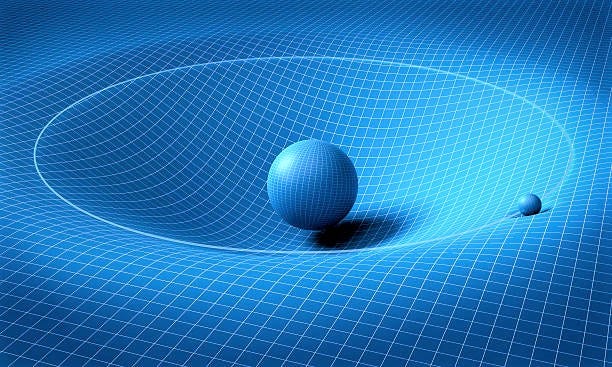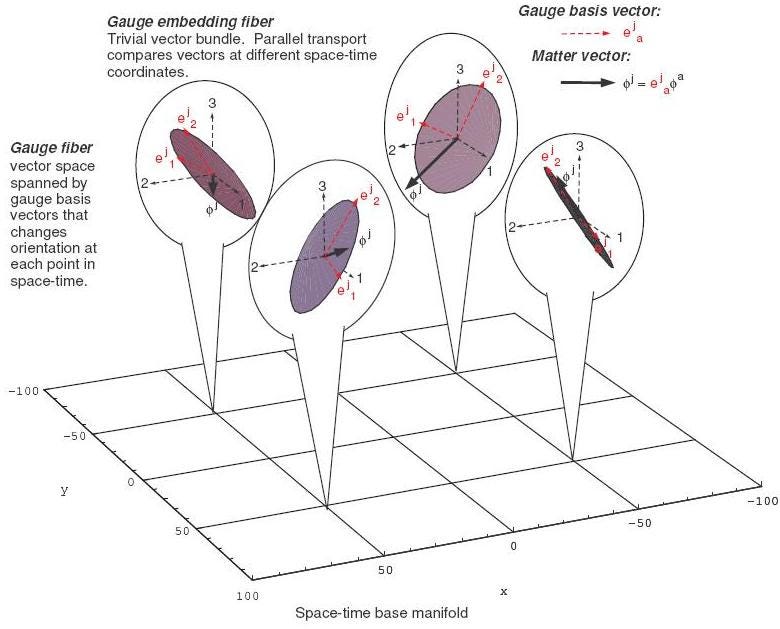Among the more or less general laws, the discovery of which characterize the development of physical science during the last century, the principle of Least Action is at present certainly one which, by its form and comprehensiveness, may be said to have approached most closely to the ideal aim of theoretical inquiry.
~Planck
Physics has much to do with understanding the nature of motion. Here’s a familiar example:
Sir Isaac Newton’s laws of motion explain the relationship between a physical object and the forces acting upon it. Understanding this information provides us with the basis of modern physics.
~NASA
[Newton wrote “For the Rays (of light) to speak properly are not colored.” He also wrote that “The science of colors becomes a speculation as truly mathematical as any other part of physics.”]
Last time, we discussed symmetry, which determines the motion of everything, everywhere. This leads us to action, which takes us to the heart of quantum theory.
The magical formula E = hv from which the whole of quantum theory is developed, establishes a universal relationship between the frequency v of an oscillatory process and the energy E associated with such a process. The quantum of action h is one of the universal constants of nature.
~Weyl
Here’s a contrarian view:
This uncertainty relation cannot play a fundamental role in a theory in which h itself is not a fundamental quantity. I think one can make a safe guess that uncertainty relations in their present form will not survive in the physics of the future.
~Dirac
And then there’s this little item, where we learn that “An experiment observed quantum leaps as they happened, revealing that these speedy little jumps are in fact gradual, rather than instantaneous.” But we won’t be getting into all that in this chapter. Back to our main topic, which began life as the principle of least action, although there were prominent forebears, as Feynman explains.
It is a most beautiful and awe-inspiring fact that all the fundamental laws of classical physics can be understood in terms of one mathematical construct called the action. It yields the classical equations of motion, and analysis of its invariances leads to quantities conserved in the course of the classical motion. In addition, as Dirac and Feynman have shown, the action acquires its full importance in quantum physics.
~Ramond
Furthermore, and now this is the point, this is the punch line, the symmetries determine the action. This action, this form of the dynamics, is the only one consistent with these symmetries [...] This, I think, is the first time that this has happened in a dynamical theory: that the symmetries of the theory have completely determined the structure of the dynamics, i.e., have completely determined the quantity that produces the rate of change of the state vector with time.
~Weinberg
OK, but what is the action? It’s a bit abstract, and the stuff above may leave the general reader wondering huh? When encountering such beasts, it’s often helpful to find introductory material from a variety of sources. Ian Stewart’s popular books on math are joy to read and he helps us along here:
The discovery was amazing. Mechanics is the study of moving bodies — cannonballs moving in a parabolic arc, pendulums swinging regularly from side to side, and planets moving in ellipses around the Sun. Optics is about the geometry of light rays, reflection and refraction, rainbows and prisms and telescope lenses. That they were connected was a surprise; that they were the same was unbelievable. (Emphasis added.)
It was also true. And it led directly to the formal setting used today by mathematicians and mathematical physicists, not just in mechanics and optics but in quantum theory too: Hamiltonian systems. Their main feature is that they derive the equations of motion of a mechanical system from a single quantity, the total energy, now called the Hamiltonian of the system. The resulting equations involve not just the position of the parts but how fast they are moving — the momentum of the system. Finally, the equations have the beautiful feature that they do not depend on the choice of coordinates.
And here is Schrödinger in his Nobel lecture:
Fermat defined the total path of a ray of light from a much more general point of view. In different media, light propagates with different velocities, and the radiation path gives the appearance as if the light must arrive at its destination as quickly as possible. (Incidentally, it is permissible here to consider any two points along the ray as the starting- and end-points.) The least deviation from the path actually taken would mean a delay. This is the famous Fermat principle of the shortest light time, which in a marvelous manner determines the entire fate of a ray of light by a single statement and also includes the more general case, when the nature of the medium varies not suddenly at individual surfaces, but gradually from place to place.
[...]
The Fermat principle thus appears to be the trivial quintessence of the wave. It was therefore a memorable occasion when Hamilton made the discovery that the true movement of mass points in a field of forces (e.g. of a planet on its orbit around the sun or of a stone thrown in the gravitational field of the earth) is also governed by a very similar general principle, which carries and has made famous the name of its discoverer since then.
Admittedly, the Hamilton principle does not say exactly that the mass point chooses the quickest way, but it does say something so similar — the analogy with the principle of the shortest travelling time of light is so close, that one was faced with a puzzle. It seemed as if Nature had realized one and the same law twice by entirely different means: first in the case of light, by means of a fairly obvious play of rays; and again in the case of the mass points, which was anything but obvious, unless somehow wave nature were to be attributed to them also. And this, it seemed impossible to do. Because the "mass points" on which the laws of mechanics had really been confirmed experimentally at that time were only the large, visible, sometimes very large bodies, the planets, for which a thing like "wave nature" appeared to be out of the question.
~Schrödinger, “The Fundamental Idea of Wave Mechanics”
This variational equation, which sums up the whole of geometrical optics, is known as Fermat's principle.
Levi-Civita
The equations of motion of a complicated mechanical system form a large number — even an infinite number — of separate differential equations. The variational principles of analytical mechanics discover the unifying basis from which all these equations follow. There is a principle behind all these equations which expresses the meaning of the entire set. Given one fundamental quantity, "action," the principle that this action be stationary leads to the entire set of differential equations. Moreover, the statement of the principle is independent of any special system of coordinates.
§
The principle of General Relativity is automatically satisfied if the fundamental "action" of the variational principle is chosen as an invariant under any coordinate transformation. Since the differential geometry of Riemann furnishes us such invariants, we have no difficulty in setting up the required field equations.
~Lanczos
I heartily recommend Lanczos; he lays it all out for us in such a way that a human being can readily understand what the heck he’s on about.
Nest up we have Dirac:
It is best to start from a classical action principle. It is very easy to see whether an action principle is relativistic or not: If the action quantity is Lorentz-invariant, everything has to be relativistic. So we see that it best to start off from an action principle.
We then make an assumption of localization: that each bit of action is localized in time. This is sufficient to provide a Lagrangian, which is just the action per unit time.~Dirac
[Relativity; Einstein-Hilbert action; Colors remain the same — they are invariant, or symmetric — under translations, rotations, & reflections. Doppler shifts due to gravity and acceleration are indistinguishable.]
The Einstein field equations we have today are generally covariant. They express the same physical truths about the universe — how space-time curves in the presence of energy and matter — regardless of what coordinates you use to label things.
~Hartnett, Quanta
[Gauge theory: Colors invariant under change of phase.]
The fact that the electromagnetic fields are invariant under these local gauge transformations turns Maxwell's theory into a gauge theory.
~’t Hooft, Gauge theories
In quantum mechanics, the essential difference is that the equations of motion of a particle are replaced by the Schrödinger equation for a wave. This Schrödinger equation is obtained from a canonical formalism, which cannot be expressed in terms of the fields alone, but which also requires the potentials. Indeed, the potentials play a role, in the Schrödinger equation, analogous to that of the index of refraction in optics. (Emphasis added.)
~Aharanov, Bohm
What’s More
The attractions of action principles include the following: (1) they are brief and elegant in expressing the laws of motion, (2) they are covariant (valid for any choice of coordinates), (3) they readily yield conservation laws from the symmetries of the system (Noether’s theorem), (4) they automatically generate covariant equations of motion (Euler-Lagrange equations), and (5) they can also generate true trajectories directly, bypassing equations of motion, via the direct or Rayleigh–Ritz method of the calculus of variations. Action principles transcend classical particle and rigid body dynamics and extend naturally to other branches of physics such as relativistic mechanics, continuum mechanics (e.g., fluid mechanics and elasticity theory), quantum mechanics, and field theory (classical and quantum) and thus play a unifying role. They have occasionally assisted in developing new laws of physics, with general relativity being perhaps the best example.
Readers may be forgiven for finding it outlandish, dragging Hamilton into a discussion of color, but there’s really no need.
In the radical relation thus contemplated by Descartes, in his view of algebraical geometry, the related things are elements of position of a variable point which has for locus a curve or a surface; and the number of these related elements is either two or three. In the relation contemplated by me, in my view of algebraical optics, the related things are, in general, in number, eight: of which, six are elements of position of two variable points of space, considered as visually connected; the seventh is an index of color; and the eighth, which I call the characteristic function,—because I find that in the manner of its dependence on the seven foregoing are involved all the properties of the system,—is the action between the two variable points; the word action being used here, in the same sense as in that known law of vision which has been already mentioned. I have assigned, for the variation of this characteristic function, corresponding to any infinitesimal variations in the positions on which it depends, a fundamental formula; and I consider as reducible to the study of this one characteristic function, by the means of this one fundamental formula, all the problems of mathematical optics... (Emphasis added.)
~Hamilton






